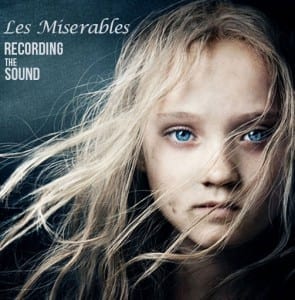2013 Oscars: Les Miserables Sound
With the Academy Awards just around the corner, we’d like to take a closer look at one of the films that has numerous Oscar nominations; Les Miserables. Specifically, we’d like to delve deeper into the sound recording process for the recent film adaptation of the classic story.

If you’ve paid any attention to the news surrounding the popular movie that came out on Christmas Day last year (and the film’s press was all but unavoidable), you probably heard that all the actors in the film recorded their vocals live. Instead of following standard film protocol and recording songs in a studio then lip-synching in the film, actors sang in real time, which presented a unique problem for sound engineers working on the musical.
Recording Live Movie Vocals
Here’s how the process worked: when filming a scene, actors would sing to a feed in their ear of a live piano player working off screen. This gave the actors the ability to adapt a live and natural performance, and the pianist followed along. The tracks were then overdubbed by an orchestra at Abbey Road Studios.
But the audio mastering geek in us wants to know how the sound crew got a vocal sound good enough for the final product in a live shot. Now we have our answer.
50 Lavalier Microphones
Production Sound Mixer, Simon Hayes, told ProSoundWeb.com that he employed 50 lavalier microphones (lapel mics) that the actors wore when singing. He also said that he would normally prefer to record such performances with boom mics, but the extravagant production prevented this method.
“Normally when I am recording a film I prioritize boom mics, especially if the scene is being shot with a single camera,” he said. “But with Les Miserables, [director] Tom [Hooper] wanted all angles covered from all sides to capture the perfect performance. This meant we couldn’t rely so heavily on the booms because the wider angle coverage would stop them getting close enough. Our solution was to come at the recording from a different angle and make lavalier microphones our priority.”
Though Hayes says he normally only works recording dialog, but enjoyed the challenge of determining how to record live singing in such an extravagant production, and said that the small mics were the perfect solution, even in adverse conditions like scenes with rain (the crew was apparently drying the mics with hairdryers between shots).
Discretion is Key
But how did we moviegoers not notice any of those numerous mics, which certainly would have stuck out in a production that otherwise perfectly encapsulates early 19th Century France? Simple, really.
“We collaborated with the costume designers to conceal cables within the clothes and to disguise the microphones that were positioned on the outside of the costumes,” Hayes said. “[The microphones’] mini concealers allowed us to mount them perfectly so they were virtually undetectable. This solved the problem of clothing rustle and, on the rare occasions when they were in shot, we were able to paint them out afterward using post production techniques.”
So that’s how you dream a dream – when you need that dream to be recorded live.




